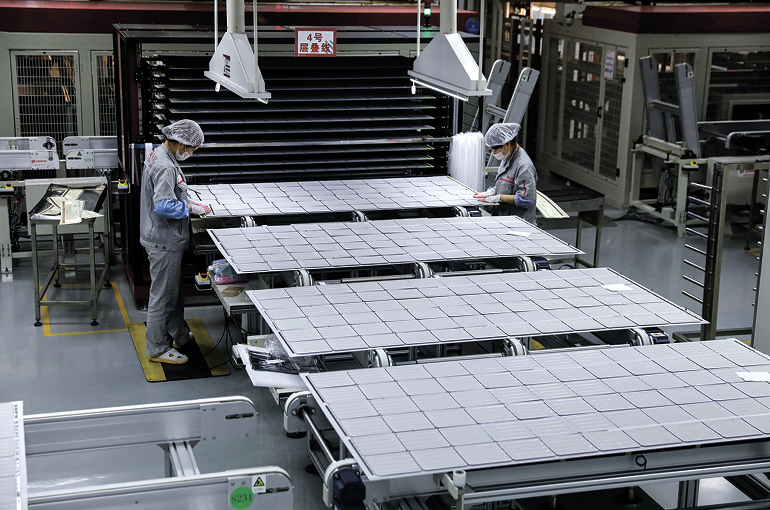 China’s Solar Industry Leaders See Earnings Sink on Panel Price Slump
China’s Solar Industry Leaders See Earnings Sink on Panel Price Slump(Yicai) May 8 -- First-quarter earnings plunged at the biggest listed players in China's photovoltaic industry after solar panel prices tumbled. Their latest trading reports also noted that the first three months of each year are an offseason for installations.
Net profit at Jinko Solar dropped 29 percent to CNY1.2 billion (USD166.3 million) from a year ago, while revenue fell 0.3 percent to CNY23.1 billion (USD3.2 billion). Trina Solar's profit sank 71 percent to CNY516 million (USD71.5 million) on a 14.4 percent decline in revenue to CNY18.3 billion. Longi Green Energy Technology and JA Solar Technology fell to a loss.
Slumping panel prices were the main reason for Jinko’s weak performance, according to the Shanghai-based firm, while profit was hit as it needed to honor long-term supply contracts with customers. Changzhou-based Trina had higher inventories at the end of the quarter and bought more raw material, which increased spending, as newly-built capacity became operational, it said.
Longi, the world's biggest PV module supplier, had a net loss of CNY2.4 billion, after revenue dropped 38 percent to CNY17.7 billion. JA Solar's lost CNY483 million on a 22 percent decline in revenue to CNY16 billion.
Longi faced grave operating challenges, Chairman Zhong Baoshen said. As more new capacity quickly came on stream, the industry has seen an imbalance in supply and demand since last year, while high-efficiency panels are replacing existing products, he added, noting that these factors dragged on the Xi'an-based firm’s earnings.
Silicon material supplier Tongwei posted a net loss of CNY787 million, compared with a net profit of CNY8.6 billion a year ago. Revenue sank 41 percent to CNY19.6 billion.
The Chengdu-based firm had a net loss of CNY2.7 billion in the fourth quarter of last year, its first quarterly loss in more than seven years. Besides slumping product prices, fixed asset impairment, caused by scrapping outdated battery capacity, was also a reason for the steep loss.
TCL Zhonghuan Renewable Energy Technology, a leading silicon wafer maker, reported a CNY880 million loss. The PV industry entered a downward cycle starting in the third quarter of 2023, and a fundamental change occurred in the sector's development environment, it noted.
Supply and Demand Imbalance
With much new capacity coming online before the end of last year, annual production capacity in various links of the global PV supply chain rose to 900 gigawatts to 1,000 GW, according to data from TCL Zhonghuan. Supply and demand was then out of kilter, hitting 2:1 at the end of last year from 1.02:1 at the end of last June.
The imbalance also led to a decline in product prices in various parts of the supply chain. The prices of mainstream modules nearly halved last year, for example, while the average slump in silicon wafer prices was more than half.
But prices have not yet bottomed out. “Although silicon prices have continued to decline for several weeks, the current drop still falls short of downstream users' expectations, and downstream sentiment remains bearish,” the silicon industry section of the China Nonferrous Metals Industry Association said in a recent report.
Upstream to downstream product prices -- from industrial silicon to PV modules -- have all fallen below cost, rendering competition irrational in the short term, the report added.
This also means that the entire sector is in an "in-depth reshuffling" that will rumble on for some time, Tongwei pointed out, with the survival space for small and mid-sized businesses narrowing yet further.
Still, Longi's Zhong remains optimistic about the outlook, despite the market’s “cold winter.” Solar panel prices will turbocharge profitability at PV power stations, stimulating more construction demand, he said, adding that new panel installation will likely continue at a record pace.
Against the backdrop of the free transformation of global energy supplies, China’s photovoltaic industry is likely to achieve sustained growth, Zhong said.
Editors: Tang Shihua, Martin Kadiev